Mar 23, 2025
National Social Security schemes are created by governments to form the first pillar of social security. In Africa, Kenya was the second country after Ghana to form a national security scheme, The National Social Security Fund (NSSF), done in 1965 through an Act of Parliament (Cap 258). It is a provident fund, which provides benefits to retiring members as a lump sum rather than through periodic payments. In recent years, discussions around the growth and reform of the NSSF have gained momentum, with key considerations on how to increase coverage, especially for the informal sector, and improve service delivery. As such, we saw it fit to cover a topical on the Kenyan National Social Security Fund to shed light on the financials, recent developments and provide recommendations to improve efficiency. We shall do this by taking a look into the following;
- Introduction to the National Social Security Fund,
- Financial Performance for the year ended 30th June 2024,
- Recent Developments at the National Social Security Fund,
- Factors hindering growth of the NSSF,
- Key considerations to improving NSSF in Kenya, and,
- Conclusion
Section I: Introduction to the National Social Security Fund
Social security is defined as any programme of social protection established by legislation, or any other mandatory arrangement, that provides individuals with a degree of income security when faced with the contingencies of old age, survivorship, incapacity, disability, or unemployment. In Kenya, the National Social Security Fund (NSSF) offers social protection to all Kenyan workers in the formal and informal sectors by providing a platform to make contributions during their productive years to cater for their livelihoods in old age and the other consequences resulting from unprecedented occurrences such as death or invalidity among others.
The National Social Security Fund (NSSF) has evolved over time having been established in 1965 through an Act of Parliament Cap 258 of the Laws of Kenya. The Fund initially operated as a Department of the Ministry of Labor until 1987 when the NSSF Act was amended transforming the Fund into a State Corporation under the Management of a Board of Trustees. The Act was established as a mandatory national scheme whose main objective was to provide basic financial security benefits to Kenyans upon retirement. The Fund was set up as a Provident Fund providing benefits in the form of a lump sum. Thereafter, the National Social Security Fund (NSSF) Act, No.45 of 2013 was assented to on 24th December 2013 and commenced on 10th January 2014 thereby transforming NSSF from a Provident Fund to a Pension Scheme. Every Kenyan with an income was required to contribute a percentage of his/her gross earnings so as to be guaranteed basic compensation in case of permanent disability, basic assistance to needy dependents in case of death, and a monthly life pension upon retirement. The Act establishes two funds namely;
- Pension Fund, and,
- Provident Fund
NSSF has gained traction over the years, but particularly in the last two years, owing to implementation of the NSSF Act of 2013, which came into effect in February 2023 and is currently in its third year of implementation. The Act increased contributions to the fund from the initial Kshs 400.0 to 12.0% of individuals' income, with the employee and employers both contributing 6.0% each. As of June 2024, total assets held by NSSF stood at Kshs 402.2 bn, a 22.6% increase from Kshs 328.1 bn in December 2023. On y/y basis the assets under management increased by 30.5% from Kshs 308.3 bn in June 2023, attributable to the higher member contributions as a result of the second phase of the implementation of the NSSF Act of 2013, which increased monthly contributions leading to higher fund inflows. The graph below shows the movement of the funds Assets Under Management from 2019 to 2024:
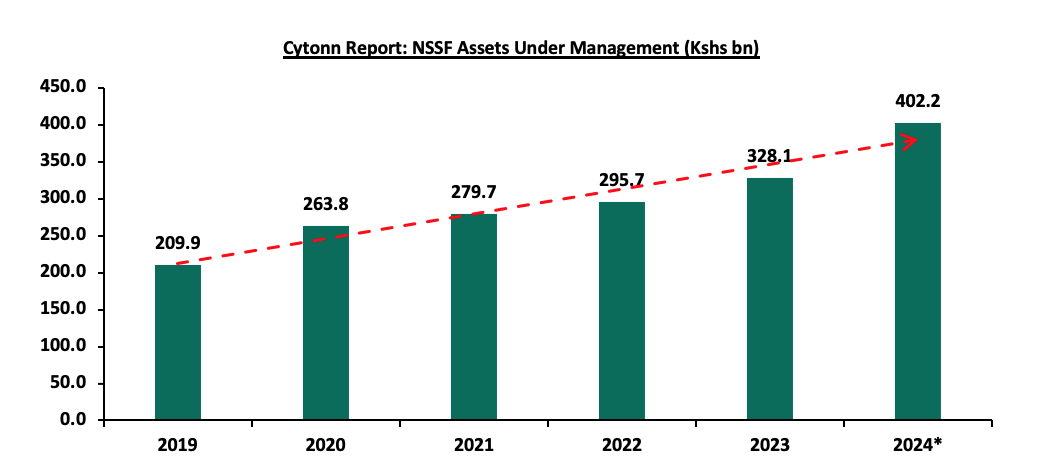
Source: RBA Annual Reports, 2024* data as of June 2024
According to the latest Retirement Benefits Authority (RBA) Annual Report, 13.1% of the total assets, amounting to Kshs 52.5 bn was managed internally by NSSF, while the remaining Kshs 348.7 bn was held by seven external fund managers. A breakdown of NSSF’s investment portfolio as of June 2024 reveals a strong preference for government securities, which accounted for 67.8% of total assets. This significant allocation is both strategic and common among pension schemes due to the safety, stability, and credibility associated with government bonds. These instruments offer guaranteed returns, minimal default risk, and predictable income streams, aligning well with the long-term investment horizon of pension funds. Beyond government securities, quoted equities made up 14.5% of the portfolio, reflecting NSSF’s exposure to publicly traded companies, while immovable property comprised 10.0% of the portfolio and 2.8% in fixed deposits. The chart below shows NSSF total assets spread as of June 2024:
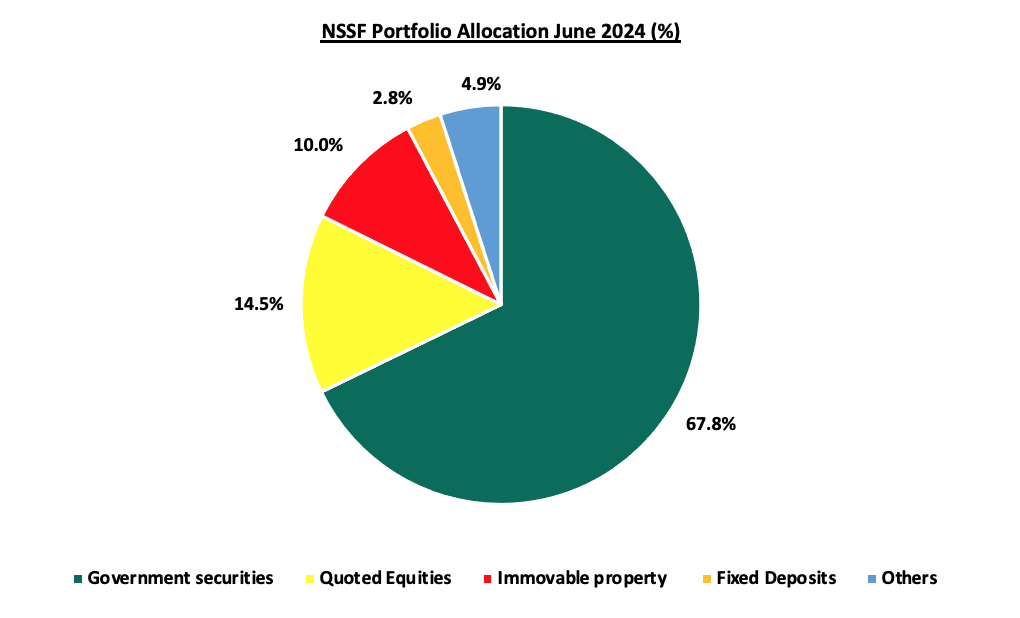
Source: RBA Annual Report June 2024
Section II: Financial Year 2023/2024 Financial Performance
The National Social Security Fund (NSSF) recorded a significant 233.4% net increase in funds to Kshs 88.0 bn for the period ending 30th June 2024, from Kshs 26.4 bn in a similar period in 2023. This was mainly driven by the 238.1% increase in the net investment income to Kshs 41.7 bn in FY’2023/24 from Kshs 12.3 bn in FY’2022/23, coupled with a 160.3% growth in the net contributions to Kshs 52.6 bn in FY’2023/24 from Kshs 20.2 bn in FY’2022/23. The performance was however weighed down by the 2.8% increase in total operating costs to Kshs 6.9 bn, from Kshs 6.7 bn in FY’2022’23. The table below shows a breakdown of NSSF statement of changes in net assets for the year ended 30th June 2024:
|
Cytonn Report: NSSF Statement of Change in Net Assets |
|||
|
FY'2022/23 |
FY'2023/24 |
y/y change |
|
|
Kshs (bn) |
Kshs (bn) |
||
|
Dealings with Member Funds |
|||
|
Remitted Member Contributions |
26.9 |
59.1 |
120.1% |
|
Unremitted Member Contributions |
0.0 |
3.1 |
- |
|
Total Contributions Receivable |
26.9 |
62.3 |
131.8% |
|
Benefits Paid |
(6.7) |
(9.7) |
45.5% |
|
Net Contributions |
20.2 |
52.6 |
160.3% |
|
Investment Income |
|||
|
FV Gain (Loss) on Revaluation of Investments |
(18.4) |
3.0 |
116.2% |
|
FV Gain (Loss) on Realization of Investments |
0.5 |
(0.2) |
(147.2%) |
|
Investment Income |
31.0 |
39.6 |
27.9% |
|
Investment Management Expenses |
(0.7) |
(0.7) |
5.2% |
|
Net Investment Income |
12.3 |
41.7 |
238.1% |
|
Other Income |
0.5 |
0.6 |
13.1% |
|
Net Revenue |
12.9 |
42.3 |
228.6% |
|
Total Operating Costs |
(6.7) |
(6.9) |
2.8% |
|
Net Increase in Fund |
26.4 |
88.0 |
233.4% |
|
Net Assets as Previously Stated |
285.7 |
312.1 |
9.2% |
|
Net Assets |
312.1 |
400.1 |
28.2% |
Source: Report of the Auditor General on NSSF June 2024
Key take outs from the table include:
- Net contributions increased by 160.3% to Kshs 52.6 bn in FY’2023/24 from Kshs 20.2 bn in FY’2022/23 attributable to the 131.8% increase in the total contributions receivable to Kshs 62.3 bn, from Kshs 26.9 bn in FY’2022/23 but was however weighed down by the 45.5% increase in the benefits paid to Kshs 9.7 bn in FY’2023/24 from Kshs 6.7 bn in FY’2022/23,
- Net Investment Income grew by 238.1% to Kshs 41.7 bn in FY’2023/24 from Kshs 12.3 bn in FY’2022/23 attributable to a 116.2% increase in the fair value gain on revaluation of investments to Kshs 3.0 bn from fair loss of Kshs 18.4 bn in FY’2022/2023 and the 27.9% increase in investment income to Kshs 39.6 bn from Kshs 31.0 bn in FY’2022/2023,
- Net revenue increased by 228.9% to Kshs 42.3 bn in FY’2023/24 from Kshs 12.9 bn in FY’2022/23,
- Total operating costs increased by 2.8% to Kshs 6.9 bn in FY’2023/24 from Kshs 6.7 bn in FY’2022/23 attributable to the 11.9 % increase in administrative costs to Kshs 7.0 bn from Kshs 6.2 bn in FY’2022/23. Investment management expenses increased by 5.2% to Kshs 0.67 bn from Kshs 0.65 bn in FY’2022/23 resulting in a 3.1% increase in the total expenses to Kshs 7.6 bn in FY’2023/24 from Kshs 7.3 bn in a similar period in 2023. Despite this increase in the Fund’s total expenses, total expenses to total assets decreased by 0.2% points to 2.4% for the year ending June 2024 from 2.6% in a similar period in 2023 but still came in above the maximum threshold which is in violation of Section 50 of the National Social Security Fund Act, 2013, that stipulates that the Fund shall not pay out more than 2.0% of its total assets in the first six years of its operation, and not more than 1.5% thereafter, and,
- Benefits paid increased by 45.5% to Kshs 9.7 bn in FY’2023/24 from Kshs 6.7 bn in FY’2022/23. Notably, payment of claims after retirement has also evolved over time growing at a 5-year CAGR of 17.2% to Kshs 9.7 bn in FY’2023/24 from Kshs 4.4 bn recorded in FY’2019/20. The graph below shows the benefits payout over the last five years;
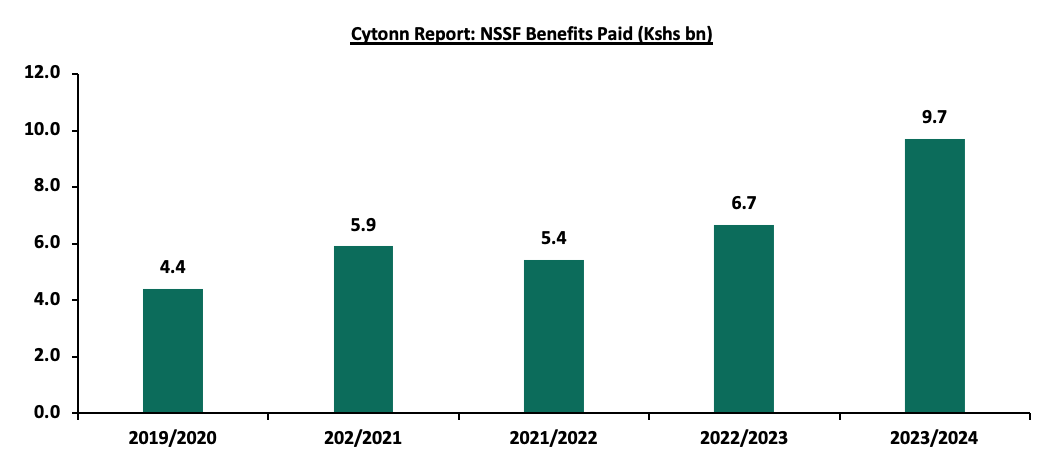
Source: NSSF Annual Reports, Report of the Auditor General on NSSF June 2024
The table below shows the NSSF statement of net assets available for benefits as of 30th June 2024:
|
Cytonn Report: NSSF Statement of Net Assets Available for Benefits |
|||||||
|
Investment Assets |
FY'2022/23 (Kshs bn) a |
FY'2023/24 (Kshs bn) B |
% Allocation FY'2022/23 c |
%Allocation FY'2023/24 d |
y/y change (a-b) |
% points change (c-d) |
|
|
Government Securities |
187.8 |
253.8 |
69.9% |
71.6% |
35.2% |
1.7% |
|
|
Quoted Stocks |
53.0 |
61.2 |
19.7% |
17.3% |
15.5% |
(2.5%) |
|
|
Term and Demand Deposits |
14.9 |
11.4 |
5.6% |
3.2% |
(23.3%) |
(2.3%) |
|
|
Accrued Income |
7.6 |
10.9 |
2.8% |
3.1% |
44.3% |
0.3% |
|
|
Eurobonds |
0.0 |
7.2 |
0.0% |
2.0% |
- |
2.0% |
|
|
Private Equity and other unlisted securities |
0.8 |
5.5 |
0.3% |
1.6% |
597.8% |
1.3% |
|
|
TPS Loans |
2.7 |
2.5 |
1.0% |
0.7% |
(5.8%) |
(0.3%) |
|
|
Corporate Bonds |
1.7 |
1.7 |
0.6% |
0.5% |
(1.1%) |
(0.2%) |
|
|
Total |
268.5 |
354.3 |
100.0% |
100.0% |
32.0% |
||
Source: Report of the Auditor General on NSSF June 2024
Key take outs from the table include:
- Government securities remained with the largest investment allocation, coming in at 71.6% in June 2024, an improvement from 69.9% recorded in June 2023. Similarly, the amounts invested in government securities as of 30th June recorded a 35.2% increase to Kshs 253.8 bn, from Kshs 187.8 bn recorded at the end of FY’2022/23. Notably, on a y/y basis the allocation government securities increased marginally by 1.7% points from 69.9% allocation recorded in FY’2022/23 mainly attributable to the high returns on government papers over the period,
- Quoted stocks recorded a decline in their investment allocation, decreasing by 2.5% points to 17.3% at the end of June 2024, from 19.7% at the end of June 2023. However, equity funds recorded a 15.5% growth in AUM to Kshs 61.2 bn in FY’2023/24, up from Kshs 53.0 bn in FY’2023/24. The increase in AUM is largely attributable to increased market activity, with the Nairobi All Share Index (NASI) registering a 19.0% gain in the six months to June 2024, as well as an improved business environment as evidenced by Purchasing Manager’s Index (PMI) registering an average of 50.0, in the six months to June 2024, from an average of 48.7 in a similar period in 2023.
- Private Equity and other unlisted securities recorded a significant 597.8% growth to Kshs 5.5 bn in June 2024, up from Kshs 0.8 bn in June 2023. Similarly, the allocation increased by 1.3% points to 1.6%, from the 0.3% recorded in a similar period in 2023, highlighting the Fund’s diversification efforts, and,
- The Fund took exposure on Eurobonds investing Kshs 7.2 bn, equivalent to 0.2% of the total net assets available for benefits and this is a result of Kenya’s February 2024 Eurobond issuance attracting institutional investors like NSSF seeking competitive yields.
The Fund’s returns increased by 7.8% points to 12.0% in FY’2023/24 from 4.2% recorded in a similar period in 2023. NSSF has recorded an average return of 6.7% over the last five years with the highest return recorded in 2021. The graph below shows the performance of the Fund’s returns over the last 5 years:
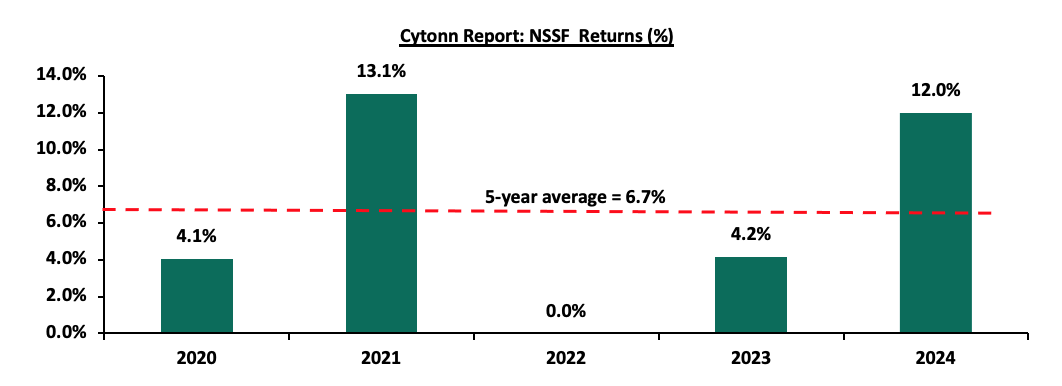
Source: NSSF Reports, Office of the Auditor General
Despite the government making NSSF mandatory, Kenya’s saving culture still lags behind in comparison to other more developed countries partly attributable to low disposable income with 35.1% of the Kenyan population as of 2023 living below the poverty line coupled with lack of sufficient knowledge on the importance of saving for retirement. The graph below shows the gross savings to GDP of select countries in the Sub-Saharan Africa Region and the developed economies;
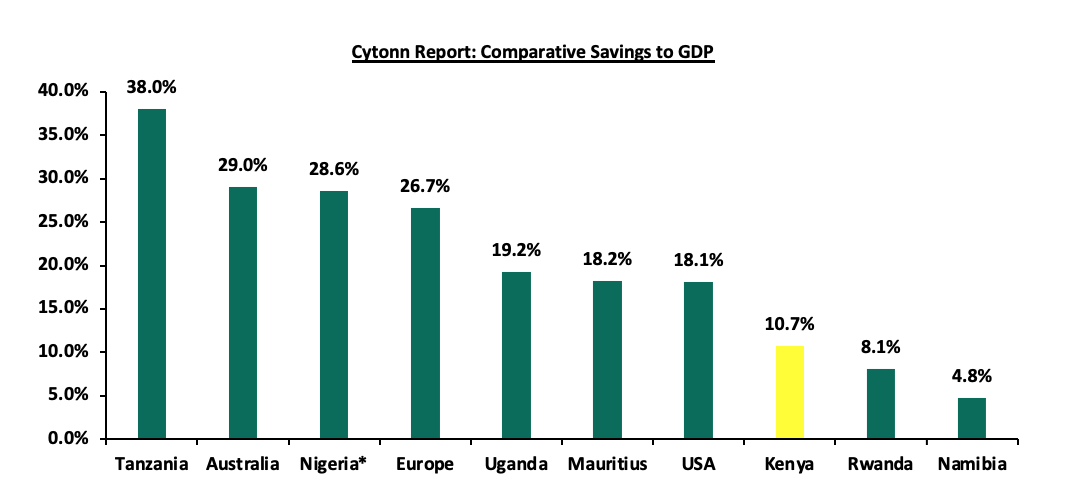
Source: World Bank, *Figures as of 2023
Section III: Recent Developments at the National Social Security Fund
In early 2025, Kenya’s National Social Security Fund (NSSF) ushered in a pivotal chapter of its evolution, marking the third year of implementing the transformative NSSF Act of 2013. With the stroke of new contribution limits effective 1st February 2025, the fund has broadened its reach, pulling more of workers’ earnings into the fold of pension savings. The lower earnings threshold has edged up from Kshs 7,000 to Kshs 8,000, while the upper limit has soared from Kshs 36,000 to Kshs 72,000, doubling the ceiling for contributions.
- Adjustments to NSSF Contribution Limits - Effective February 1, 2025, the contribution limits governing pensionable income were adjusted, reflecting an ambitious push to secure stronger retirement benefits for workers. The lower earnings limit, previously set at Kshs 7,000, rose to Kshs 8,000, lifting the minimum monthly contribution from Kshs 420 to Kshs 480 per employee, with employers matching this amount to total Kshs 960 for Tier I. Meanwhile, the upper earnings limit has doubled, leaping from Kshs 36,000 to Kshs 72,000. This shift pushes the maximum contribution to Kshs 4,320 per employee—matched equally by employers—resulting in a combined total of Kshs 8,640 for those earning Kshs 72,000 or more. For an employee earning Kshs 50,000, the deduction now stands at Kshs 3,000, up from Kshs 2,160, illustrating how these changes reach across income brackets, capturing a larger slice of salaries for pension savings.
This expansion, however, is a double-edged sword. For employees, particularly those at the lower end of the income spectrum, the increase from Kshs 420 to Kshs 480 trims take-home pay by an additional Kshs 60 monthly, a modest figure that nonetheless bites into budgets already stretched by rising costs. Mid-tier earners, such as those at Kshs 50,000, face a steeper Kshs 840 increase, while high earners see their contributions double, promising greater retirement security at the expense of current liquidity. Employers, too, feel the weight of these adjustments. A business with a handful of employees earning above Kshs 72,000 now shoulders an additional Kshs 2,160 per worker each month, a burden that could strain small enterprises or prompt larger firms to rethink staffing strategies. Yet, there’s a potential relief valve: employers with private pension schemes can opt out of Tier II contributions, redirecting funds to approved alternatives, though this requires navigating regulatory hoops. The adjustments, effective from February this year, are summarized as follows:
|
Cytonn Report: NSSF Contribution Limits Adjustments |
||
|
Year 2 (Previous Rates) |
Year 3 (New Rates Commenced February 2025) |
|
|
Lower Limit (Tier 1) |
7,000 |
8,000 |
|
Total Contribution by Employee |
420 |
480 |
|
Total Contribution by Employer |
420 |
480 |
|
Total Tier 1 NSSF Contributions |
840 |
960 |
|
Upper Limit (Tier 2) |
36,000 |
72,000 |
|
Contribution on Upper Limit (6% of Upper Limit Less Lower Limit) |
29,000 |
64,000 |
|
Total Contribution by Employee |
1,740 |
3,840 |
|
Total Contribution by Employer |
1,740 |
3,840 |
|
Total Tier 2 NSSF Contributions |
3,480 |
7,680 |
|
Total NSSF Contributions |
4,320 |
8,640 |
Source: www.nssf.or.ke
- Court of Appeal Ruling Reinforcing SRC Oversight of NSSF Salaries - On March 6, 2025, the Court of Appeal reinstated the Salaries and Remuneration Commission’s (SRC) authority to regulate salaries at the National Social Security Fund (NSSF), reversing a prior judgment that had excluded NSSF from SRC oversight. The court classified NSSF as a public entity, citing its management of mandatory worker contributions as public funds, thus placing its employees under SRC jurisdiction as public officers. This decision resolves a legal dispute initiated over a decade ago when SRC’s circular on state corporation remuneration faced opposition from employee unions, sparking prolonged litigation.
The ruling mandates SRC to establish standardized salary frameworks for NSSF staff, aligning compensation with public sector policies. This could disrupt existing collective bargaining agreements and reshape future employment terms, enhancing fiscal discipline over NSSF’s operational costs. Given NSSF’s role in managing public pension funds, this strengthens accountability but may strain labor relations if wage adjustments lag behind inflation or market rates. - Stagnation in NSSF Bond Trading Investigation - The investigation into alleged irregular bond trading at NSSF, launched by the Capital Markets Authority (CMA) in September 2024, has shown no significant progress by March 19, 2025. The probe targeted transactions between May and July 2024, where bonds were reportedly bought at above-market prices and sold at losses, potentially benefiting select individuals. Initial momentum including summons of Central Bank of Kenya (CBK) and CMA officials by the National Assembly’s Finance and National Planning Committee has dissipated. Challenges include delays in accessing digital communication evidence and a leaked internal letter that may have compromised the inquiry by alerting suspects to delete data.
The lack of updates suggests operational or political hurdles in enforcing financial oversight, undermining confidence in CMA’s regulatory capacity. With NSSF’s total assets at Kshs 400.1 bn as of June 2024, any unresolved mismanagement could erode member returns, highlighting systemic risks in transparency and governance within Kenya’s pension sector. Below is the performance summary for the last reported years, compared to the estimated returns from a portfolio of 60.0% bonds and 40.0% equities:
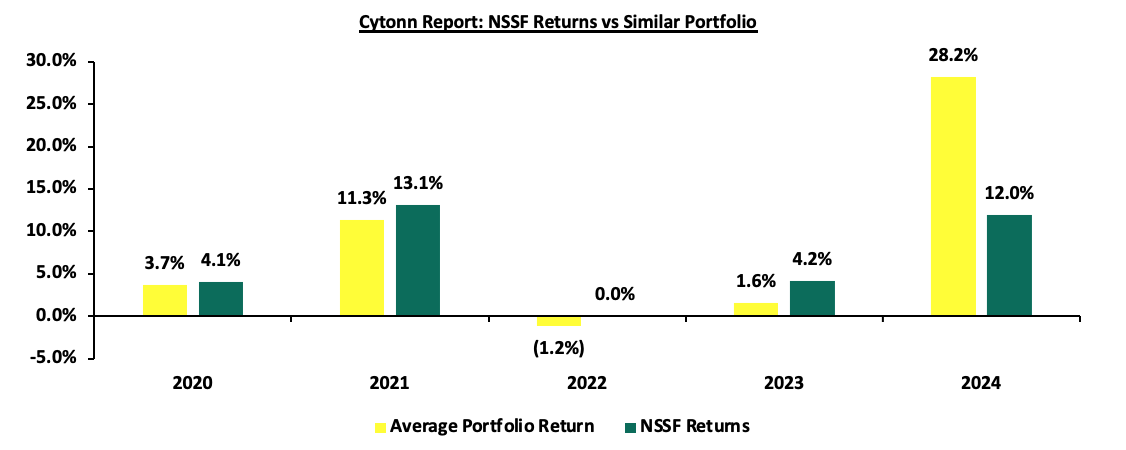
Source: NSSF strategic plan 2023-2027
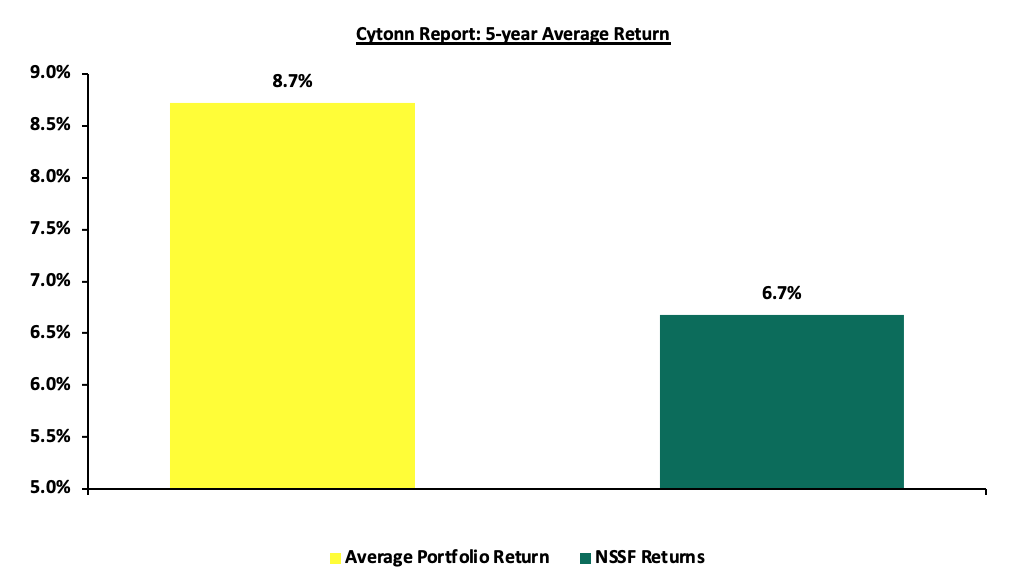
Source: Cytonn Research, NSSF strategic plan 2023-2027
On average, the NSSF portfolio has underperformed by 2.0 percentage points compared to a comparable benchmark. While NSSF recorded a return of 6.7%, a similarly constructed portfolio—split between 60.0% government bonds and 40.0% equities from the NASI—achieved 8.7% over the same period. While there may be a number of reasons for this, occurrences such as the irregular bond trades could definitely have contributed to this.
- NSSF’s Mixed-Use Development Project in Nairobi CBD - The National Social Security Fund (NSSF) is advancing a multibillion-shilling mixed-use development on a 3.9-acre site at the Uhuru Highway and Kenyatta Avenue intersection in Nairobi’s central business district. Vacant for decades due to legal and ownership disputes, the plot will be developed under an EPC+F (Engineering, Procurement, Construction, and Financing) model, delegating design, construction, and funding to private contractors. Announced in late 2024, the project aims to integrate residential, commercial, and hospitality components, reflecting NSSF’s strategy to optimize its real estate portfolio.
This initiative leverages NSSF’s financial capacity to generate long-term returns, with the EPC+F model mitigating direct fiscal risk. Success hinges on contractor selection and market demand, potentially boosting Nairobi’s urban infrastructure while diversifying NSSF’s income streams. However, historical disputes over the site signal execution risks that could delay timelines or inflate costs.
Section IV: Factors Hindering the Growth of NSSF
The growth of Kenya’s National Social Security Fund (NSSF) has been constrained by a combination of interconnected factors affecting its efficiency, financial stability, and capacity to deliver sufficient retirement benefits. In this regard, we examine the key challenges that have hindered the fund’s growth as follows:
- Unremitted Contributions: The fund has struggled with unremitted contributions from state corporations, government-owned enterprises, and semi-autonomous agencies. By the end of FY’2023/24, unremitted member contributions to the NSSF had risen to Kshs 3.1 bn. This sharp rise underscores a widening funding gap that jeopardizes the fund’s capacity to fulfill its retirement obligations,
- Leadership and Governance Issues: The NSSF has struggled with ongoing governance challenges, including accusations of mismanagement and corruption. Probes into corruption allegations involving senior officials have eroded trust in the fund's leadership. The NSSF has faced persistent governance issues, including allegations of mismanagement and corruption. Investigations into corruption allegations involving senior officials at the NSSF have undermined confidence in the fund’s management. Senior officials have been accused of suspicious irregular bond dealings between May and July 2024 in order to generate illegal profits for the participants. This has sparked demands for reforms; however, progress has been hindered by bureaucratic obstacles and resistance from vested interests. The absence of strong governance has led to inefficiencies and continued mismanagement,
- High Unemployment Rate in Kenya: The unemployment rate in Kenya stood at 5.6% at the end of 2023, and is projected at 7.2% in 2025; Largely due to the country's economic development challenges, coupled with a growing youth population. This has raised the dependency ratio among the working population, making it harder for them to allocate funds toward social security contributions for their retirement. As a result, the National Social Security Fund (NSSF) faces slower growth, with fewer contributors limiting its ability to expand its asset base,
- Slow Economic Growth: Kenya’s economy has faced persistent slow growth, with an average GDP growth rate of 4.5% over the last 5 years. This slow economic performance has resulted in low-income levels for many citizens, directly impacting their ability to make regular contributions to the National Social Security Fund (NSSF). Furthermore, inflation and increasing cost of living have reduced disposable income, making it difficult for both individuals and employers to meet their NSSF obligations. This economic stagnation has contributed to lower contribution inflows, limiting the fund's ability to grow its asset base and deliver adequate retirement benefits,
- Government Interference – As a government-owned institution, the NSSF is directly affected by legislative changes, particularly increased taxation, which negatively impacts its growth and operations. Additionally, while the rise in NSSF contribution rates aims to enhance fund collections, it has also increased employment costs. Employers, required to match employee contributions, face higher expenses, discouraging formal employment and ultimately limiting overall contributions. This challenge is further exacerbated by Kenya’s already high unemployment rate. Critics have also argued that the NSSF reforms lacked sufficient public consultation, raising concerns about whether the NSSF Act met constitutional requirements for public participation. As a result, legal disputes and resistance have increased challenging the implemented reforms, further obstructing the growth and stability of NSSF, and,
- Negative Perception of NSSF- The rampant governance issues faced by NSSF has led to mistrust of the fund by the general public due to allegations due to mismanagement and corruption practiced by the top leaders of the office. This has resulted in lack of faith in the scheme and members opting out of contributing their Tier II contributions to the fund and remitting to private pensions schemes managed by fund managers and administrators thus hindering the growth of the fund.
Section V: Key Considerations for Improving NSSF in Kenya
We note that the government has consistently tried to promote a savings culture in the country through various reforms, including raising contribution rates and making contributions mandatory. For instance, in the NSSF Act 2013, the government recommended a mandatory registration contribution to NSSF by employees and employers. The Act aimed to enhance the sustainability of retirement benefits for Kenyan workers. Key provisions of the Act include an increase in contribution rates, from a flat rate of Kshs 400.0 to 12.0% of an employee's monthly earnings, with 6.0% contributed by the employee and an equal amount by the employer.
However, the enactment of the Act has faced legal challenges. Multiple petitions were filed questioning its constitutionality, leading to a decision by the Employment and Labor Relations Court (ELRC). On September 19, 2022, in Kenya Tea Growers Association & 8 Others v. NSSF Board & Others, the ELRC ruled that the Act was unconstitutional on the basis of;
- The provisions of the NSSF Act, 2013 were not subjected to public participation and were not tabled before the Senate prior to its enactment as per constitutional requirements,
- Imposing mandatory registration and contribution to NSSF would have overburdened employees and consequently reduce disposable income since a vast majority of employees have their pay slips already strained due to their various financial commitments with other institutions and their subscription to other pensions schemes, and,
- The provisions of the Act would have given NSSF a competitive advantage thus making the Fund a monopoly in the provision of pension and social security services in the country.
After this ruling, the NSSF Board of Trustees filed an appeal, and the case eventually reached the Supreme Court of Kenya. The Supreme Court assessed whether the ELRC had the authority to determine the Act's constitutionality. In the end, the court upheld the ELRC’s jurisdiction but referred the case to the Court of Appeal for further review. In our opinion, the following are key actionable steps that can be considered to drive NSSF’s growth while striving to balance the interests of the government, employers, and employees.
- Mass education on developing a savings culture – It is crucial to educate Kenyans on the importance of developing a savings culture, particularly young people in the informal sector perceive retirement planning as something meant only for older people rather than a long-term financial necessity. Additionally, many Kenyans tend to be less concerned about retirement planning, relying on the expectation that their children will support them in the future. This mindset hinders individuals from voluntarily enrolling in schemes like the NSSF, even when they have a steady source of income. There’s also a need for mass education to the public on the implemented NSSF Act of 2013 in terms of how it’s going to affect employees, employers and the government and also the benefits to be realized by the stakeholders,
- Ensure involvement of all stakeholders in NSSF reforms – It is essential to involve the general public and all stakeholders in any proposed NSSF reforms. As mentioned earlier, the High Court had nullified the NSSF Act of 2013, which sought to raise monthly contributions from Kshs 200.0 to Kshs 2,160.0, citing a lack of public participation—a constitutional requirement for major policy decisions. Furthermore, the Act's promoters failed to secure Senate approval, despite its impact on county employees and the financial operations of devolved governments. Higher pension contributions will strengthen the NSSF by expanding the retirement fund and improving workers' replacement ratios compared to the current system, and,
- Enforcement of compliance from employers – Unremitted contribution increased to Kshs 3.1 bn in FY’2023/24 and thus there is a need for NSSF to eliminate any loopholes to ensure that all employers fully comply with contribution remittance. This can be achieved by integrating technologies that centralize payroll-related contributions onto a single platform, enhancing efficiency, streamlining record reconciliation, and identifying employers who make partial remittances,
- Streamline operational efficiency – In the financial year ended 30th June 2024, NSSF’s total expenses increased by 3.1% to Kshs 7.6 bn, with the total expenses to AUM ratio decreasing by 0.2% points to 2.4% in FY’2023/24 from 2.6% FY’2022/23, but still above the 2.0% maximum threshold. To better serve the interests of all stakeholders, NSSF should implement proactive measures to enhance efficiency and reduce unnecessary expenses.
Section VI: Conclusion
The National Social Security Fund (NSSF) has seen quite a turnaround in its performance due to its implemented strategies such as diversification of its investments in high yielding investments as well as increased contribution due to implementation of the revived NSSF Act of 2013. However, there are still some challenges that threatens its credibility and the financial security of its members that needs to be addressed. For countless retirees, the NSSF represents a lifetime of dedication and sacrifice, making the protection of their benefits essential. Restoring trust requires the establishment of robust oversight mechanisms, including independent audits and strict adherence to remittance timelines. Now is the time for all stakeholders—government, regulators, and fund management—to come together in a unified effort to strengthen the NSSF, ensuring it continues to secure the retirement futures of millions of Kenyans. Swift action is imperative, as it will help alleviate old-age poverty and provide a stable income to replace earnings in retirement.
Disclaimer: The views expressed in this publication are those of the writers where particulars are not warranted. This publication, which is in compliance with Section 2 of the Capital Markets Authority Act Cap 485A, is meant for general information only and is not a warranty, representation, advice or solicitation of any nature. Readers are advised in all circumstances to seek the advice of a registered investment advisor.

